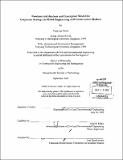Fundamental analysis and conceptual model for corporate strategy in global engineering and construction markets
Author(s)
Cheah, Yuen Jen, 1972-
DownloadFull printable version (28.31Mb)
Other Contributors
Massachusetts Institute of Technology. Dept. of Civil and Environmental Engineering.
Advisor
John B. Miller.
Terms of use
Metadata
Show full item recordAbstract
Strategic management as an academic field of study has spanned over four decades. As an interdisciplinary subject that enjoys concurrent contributions by allied disciplines such as economics and social science, numerous industries have benefited from applying tools and concepts developed within strategic management that are subsequently tailored to match their specific contexts. Strangely, although postured as one of the oldest and largest industries, the construction industry has largely chosen to omit the relevance of the subject in daily business operations. This is especially true in the United States, compared to the British who have embarked on such studies as early as the 1970s. Recent literatures have commented on inadequate management knowledge and systems perspective of civil engineers as they rise through the ranks and shoulder higher responsibilities of management. This is manifested by lackluster performance and failure of several international construction firms sampled in this research, the causes of which were least attributed to technical engineering issues and project management aspects. This doctoral research aims to bridge the knowledge gap in strategy and formulates a conceptual model suited for construction. Twenty-four large international construction firms originating in the U.S., Europe and Japan are selected for the study. Fundamental analysis, a common methodology used in economics and investment studies, forms the quantitative approach to extract information from publicly available data. The theoretical foundation is then drawn from the intellect of different schools of strategic thought that have accumulated over the years. (cont.) Both complementary components combine for the development of the conceptual model, which is supported and refined in consideration of factual information observed from the firm sample. The conceptual model builds on seven strategic fields, two organizational mechanisms and a boundary notion that divides the external environment from the internal aspects of a firm. The model works as a process that runs parallel to mainstream strategic management functions. Two main conclusions are derived: (1) fields and mechanisms should function as variables to react dynamically to ever changing external conditions; (2) interaction among these variables automatically promotes higher order differentiation factors that enhance the strategic outlook of a firm.
Description
Thesis (Ph. D .)--Massachusetts Institute of Technology, Dept. of Civil and Environmental Engineering, 2002. Includes bibliographical references (p. 329-339).
Date issued
2002Department
Massachusetts Institute of Technology. Department of Civil and Environmental EngineeringPublisher
Massachusetts Institute of Technology
Keywords
Civil and Environmental Engineering.